Benzyl isothiocyanate alters the gene expression with cell cycle regulation and cell death in human brain glioblastoma GBM 8401 cells
- Authors:
- Published online on: January 19, 2016 https://doi.org/10.3892/or.2016.4577
- Pages: 2089-2096
Abstract
Introduction
Glioblastomas are the most frequent and aggressive primary brain cancers in adults (1) with a high recurrence and mortality rate (2). Glioblastoma prognosis is poor and there are limited therapeutic options. In recent years, advances have been made in multimodality including surgery, radiotherapy, chemotherapy and biotherapy, but the overall 5-year survival rate is still <3% for patients with glioblastoma (3). Thus, we try to identify prognostic gene expression (upregulation or downregulation) that may contribute to evaluate a more effective treatment to improve patient survival and to address more precisely the use of comprehensive therapy.
Benzyl isothiocyanate (BITC), one of the isothiocyanates, is present in cruciferous plants, it acts against carcinogenesis (4,5) and induces cell death through the induction of apoptosis and cell cycle arrest in various human cancer cells (6–10). In human prostate cancer cells, BITC promoted the phosphorylation of Bcl-xL with simultaneous cell cycle arrest and subsequent apoptosis (11). In our previous studies we have demonstrated that BITC inhibited migration and invasion in human colon (12) and gastric (13) cancer cells in vitro. There is no available information to show whether BITC affects human brain tumor cells, in particular regarding the effects of BITC on gene expression in human glioblastoma cells.
In cell survival, to maintain the integrity of genomic and mitochondrial DNA is critically important. It was reported that damage to nuclear and mitochondrial DNA can increase the accumulation of defective cellular components leading to impact unfavorably on physiological functions, increasing entropy (14). If an agent induces DNA damage, the cell in order to respond to the DNA damage, activates the cell cycle checkpoints (G1, S and G2/M) to stop cell cycle progression in order to allow time for repair, thereby preventing transmission of damaged or incompletely replicated chromosomes (15). Thus, the associated gene expression regarding cell cycle progression, cell apoptosis and DNA damage in cells are important for cancer cell therapy. There is no previous study showing the anticancer properties of BITC at the genetic level of human glioblastoma. We investigated the effects of BITC on gene expression in human brain cancer glioblastoma multiforme (GBM 8401) in vitro.
Materials and methods
Chemicals and reagents
BITC, dimethyl sulfoxide (DMSO), penicillin-streptomycin and trypsin-EDTA were obtained from Sigma Chemical Co. (St. Louis, MO, USA). RPMI-1640 culture medium and fetal bovine serum (FBS) were purchased from Gibco-BRL/Invitrogen (Carlsbad, CA, USA). Tissue culture flasks and plates were obtained from Gibco-BRL/Invitrogen.
Cell culture
Human brain glioblastoma GBM 8401 cells were purchased from the Food Industry Research and Development Institute (Hsinchu, Taiwan) and cultured following the supplier's instructions. Cells were grown in 75 cm2 culture flasks with RPMI-1640 medium supplemented with 10% FBS, 100 U/ml penicillin and 100 µg/ml streptomycin and maintained in an atmosphere of 5% CO2 and 95% air at 37°C. The medium was changed every 2 days (16).
Cell morphological changes and viability assays
GBM 8401 cells (8×104 cells/ml) were seeded into a 12-well plate containing RPMI-1640 medium for 24 h. In addition, BITC was added to wells at the final concentration of 6 µM for 0, 12, 24 and 48 h. After treatment, cells were examined and photographed using contrast-phase microscopy at a magnification of ×400 and then harvested for measuring the total percentage of viable cells using flow cytometric assay (16).
Annexin V/PI staining for cell apoptosis
GBM 8401 cells (8×104 cells/ml) were seeded into a 12-well plate for 24 h and then treated with BITC (0 and 6 µM) for 0, 12, 24 and 48 h, and the cells were collected, washed with phosphate-buffered saline (PBS) and stained with Annexin V/propidium iodide (PI) staining kit (BD Biosciences, San Diego, CA, USA) (17). All samples were then immediately analyzed by flow cytometry.
cDNA microarray assay for gene expression
GBM 8401 cells (2.4×106 cells/dish) were maintained in a 10 cm dish for 24 h. Cells were treated with 6 µM BITC or DMSO for 48 h then cells were collected, and washed twice with PBS. All samples were further isolated in total RNA using Qiagen RNeasy Mini kit (Qiagen, Valencia, CA, USA). The isolated RNA was further conducted for cDNA synthesis, labeling and microarray hybridization. The fluorescent-labeled cDNA hybridization (Affymetrix GeneChip Human Gene 1.0 ST array; Affymetrix, Santa Clara, CA, USA) on the chip was conducted (18), and the fluorescence from each sample was measured by Asia BioInnovations Corporation (Taipei, Taiwan). Expression Console software (Affymetrix) with default RNA parameters (19,20) was used to analyze the data. BITC affecting gene expression with at least a 2-fold-change was considered significant and recorded.
Results
Cytotoxic effects of BITC in GBM 8401 cells
To investigate the cytotoxic effects of BITC in GBM 8401 cells, after treatment of cells with 6 µM BITC for 0, 12, 24 and 48 h, the cell morphological changes and percentage of viable cells were measured and results are presented in Fig. 1A and B, respectively. BITC induced cell morphological changes and decreased cell viability in GBM 8401 cells and these effects are time-dependent (Fig. 1A and B).
Induction of cell apoptosis in GBM 8401 cells after exposure to BITC
In order to further examine whether cell death was induced by BITC and through the induction of cell apoptosis, the cells after treatment with 6 µM BITC were harvested and apoptotic cells were measured by Annexin V/PI staining, and the results are presented in Fig. 2. Based on the data in Fig. 2, BITC-induced apoptotic cell death and these effects are time-dependent. The treatment of cells with BITC increased the total apoptotic cell death to 36.81% at 48 h (Table I). The result is consistent with the morphology and examination of total viable cells.
BITC alters the regulations of gene expression in GBM 8401 cells
GBM 8401 cells were treated with or without 6 µM BITC for 48 h and then harvested for total RNA extraction. The expression of the top 10 up- and downregulated genes was estimated by cDNA microarray analysis and the results are presented in Tables II and III. BITC induced 317 upregulated genes and 182 downregulated genes of GBM 8401, respectively. Fourty-six genes were upregulated in the range >3–<4-fold, and 198 genes were upregulated >2–<3-fold. One gene was downregulated >4-fold, and 11 genes were downregulated in the range >3–<4-fold, and 170 genes were downregulated >2–<3-fold (data not shown).
Alterations in gene expression scored in GBM 8401 cells after exposure to BITC
The data from GeneGo analysis were mapped and are shown as upward thermometers in red color and indicate upregulated signals and downward (blue) ones indicate downregulated expression levels of the genes as presented in Figs. 3Figure 4–5. Fig. 3 shows the Development_Hedgehog and PTH signaling pathways in bone and cartilage development. Fig. 4 shows the transcription and epigenetic regulation of gene expression and Fig. 5 shows the Development_TGF-β-dependent induction of EMT via MAPK.
Discussion
Numerous studies have shown that BITC present biological activities including anticancer function in vitro. In the present study, BITC-induced cell morphological changes (Fig. 1A) and decreased the percentage of viable GBM 8401 cells and these effects are time-dependent (Fig. 1B). We also used Annexin V/PI staining to show that BITC-induced cell death through the induction of cell apoptosis in GBM 8401 cells (Fig. 2 and Table I) these effects are time-dependent. In order to further examine whether or not BITC affects gene expression of GBM 8401 cells, we treated cells with 6 µM of BITC for 24 h before cells were harvested, total RNA was extracted for cDNA microarray and underwent further analysis for gene expression and the results are shown in Tables II and III.
It is well documented that after cells are exposed to anticancer agents, it may cause DNA damage or induce cell cycle arrest for causing cell death (21–23). We found that BITC decreased total viable cell number (Fig. 1B) based on cells incubated with BITC and then harvesting and staining by PI and examination by flow cytometric assay as previously described (24,25). We also confirmed cell apoptosis by Annexin V/PI staining and evaluation by flow cytometry and results indicated that BITC significantly induced cell death in GBM 8401 cells in vitro (Fig. 2).
Table II indicates that expression of 317 genes was promoted, and among them two genes associated with DNA damage in GBM 8401 cells, the DNA-damage-inducible transcript 3 (DDIT3) was increased 3.66-fold, and the growth arrest and DNA-damage-inducible α (GADD45A) was increased 2.34-fold. Based on these observations, BITC induced DNA damage as shown previously (9), our results indicated that BITC-induced DNA damage was associated with gene expression. Table II indicates that BITC also promoted four heat protein gene expression, the heat shock protein 70 kDa family member 13 (HSPA13), which was increased 2.16-fold, the heat shock protein 70 kDa protein 1A, 1B (HSPA1A) increased 2.13-fold [heat shock protein 90 kDa β (Grp94), membrane 2, pseudogene (HSP90B2P)] and increased 2.03-fold. It was reported that heat shock proteins (HSPs) have anti-apoptotic properties and they are often elevated in many human cancers; furthermore, the overexpression of HSPs is associated with poor survival and response to therapy (26–28). HSP expression in selected brain tumor cell lines (27,29) have been reported using mainly immunohistochemistry (29–31). Table II indicates that BITC also promoted expression of seven genes associated with cell cycle such as CLK (CDC-like kinase 4), which was increased 3.29-fold, CCNG2 (cyclin G2) was increased 3.19-fold, cyclin A1 (CCNA1) increased 2.30-fold, cyclin Y-like 1 (CCNYL1) increased 2.20-fold, cyclin-dependent kinase-like 5 (CDKL5) increased 2.19-fold, cyclin D binding myb-like transcription factor 1 (DMTF1) increased 2.04-fold and cell cycle progression 1 (CCPG1) was increased 2.01-fold in GBM 8401 cells.
Table III indicates that it suppressed expression of 182 genes in GBM 8401 cells, and among them a gene associated with receptor for cell responses to stimuli, the EGF containing fibulin-like extracellular matrix protein 1 (EFEMP1) was inhibited 2.01-fold, and the TNF receptor-associated protein 1 (TRAP1) was inhibited 2.08-fold. Both receptors are associated with cell sensitivity for stimuli agents (32,33). Furthermore, BITC inhibited mitochondria ribosomal genes such as mitochondrial ribosomal protein; tumor protein D52 (MRPS28) was inhibited 2.06-fold, mitochondria ribosomal protein S2 (MRPS2) decreased 2.07-fold, mitochondria ribosomal protein L23 (MRPL23) decreased 2.08-fold, mitochondria ribosomal protein S2 (MRPS2) decreased 2.07-fold, mitochondria ribosomal protein S12 (MRPS12) decreased 2.08-fold, mitochondria ribosomal protein L12 (MRPL12) decreased 2.25-fold and mitochondria ribosomal protein S34 (MRPS34) was decreased 2.30-fold in GBM 8401 cells. It is well documented that agents inducing cancer cell apoptosis are involved in the mitochondria (34,35), thus, in the present study, we found that BITC-induced cell death may be through the induction of DNA damage and affects mitochondria ribosomal gene expression in GBM 8401 cells.
In conclusion, we found that many genes are associated with DNA damage and cell cycle regulation and various genes that associated with the mitochondria were affected by BITC in GBM 8401 cells. These changes of gene expression in GBM 8401 cells, after exposure to BITC, provide further knowledge on the effects of BITC at the genetic level, and for future development of potential biomarkers for glioblastoma therapy.
Acknowledgments
The present study was supported by grant no. CMU103-ASIA-01 from the China Medical University, Taichung, Taiwan.
References
|
Di Cristofori A, Ferrero S, Bertolini I, Gaudioso G, Russo MV, Berno V, Vanini M, Locatelli M, Zavanone M, Rampini P, et al: The vacuolar H+ ATPase is a novel therapeutic target for glioblastoma. Oncotarget. 6:17514–17531. 2015. View Article : Google Scholar : PubMed/NCBI | |
|
Wen PY and Kesari S: Malignant gliomas in adults. N Engl J Med. 359:492–507. 2008. View Article : Google Scholar : PubMed/NCBI | |
|
Stupp R, Mason WP, van den Bent MJ, Weller M, Fisher B, Taphoorn MJ, Belanger K, Brandes AA, Marosi C, Bogdahn U, et al European Organisation for Research and Treatment of Cancer Brain Tumor and Radiotherapy Groups; National Cancer Institute of Canada Clinical Trials Group: Radiotherapy plus concomitant and adjuvant temozolomide for glioblastoma. N Engl J Med. 352:987–996. 2005. View Article : Google Scholar : PubMed/NCBI | |
|
Nakamura Y and Miyoshi N: Cell death induction by isothiocyanates and their underlying molecular mechanisms. Biofactors. 26:123–134. 2006. View Article : Google Scholar : PubMed/NCBI | |
|
Sehrawat A and Singh SV: Benzyl isothiocyanate inhibits epithelial-mesenchymal transition in cultured and xenografted human breast cancer cells. Cancer Prev Res. 4:1107–1117. 2011. View Article : Google Scholar | |
|
Huang SH, Wu LW, Huang AC, Yu CC, Lien JC, Huang YP, Yang JS, Yang JH, Hsiao YP, Wood WG, et al: Benzyl isothiocyanate (BITC) induces G2/M phase arrest and apoptosis in human melanoma A375. S2 cells through reactive oxygen species (ROS) and both mitochondria-dependent and death receptor-mediated multiple signaling pathways. J Agric Food Chem. 60:665–675. 2012. View Article : Google Scholar | |
|
Singh SV, Srivastava SK, Choi S, Lew KL, Antosiewicz J, Xiao D, Zeng Y, Watkins SC, Johnson CS, Trump DL, et al: Sulforaphane-induced cell death in human prostate cancer cells is initiated by reactive oxygen species. J Biol Chem. 280:19911–19924. 2005. View Article : Google Scholar : PubMed/NCBI | |
|
Wicker CA, Sahu RP, Kulkarni-Datar K, Srivastava SK and Brown TL: BITC sensitizes pancreatic adenocarcinomas to TRAIL-induced apoptosis. Cancer Growth Metastasis. 2009:45–55. 2010.PubMed/NCBI | |
|
Wu CL, Huang AC, Yang JS, Liao CL, Lu HF, Chou ST, Ma CY, Hsia TC, Ko YC and Chung JG: Benzyl isothiocyanate (BITC) and phenethyl isothiocyanate (PEITC)-mediated generation of reactive oxygen species causes cell cycle arrest and induces apoptosis via activation of caspase-3, mitochondria dysfunction and nitric oxide (NO) in human osteogenic sarcoma U-2 OS cells. J Orthop Res. 29:1199–1209. 2011. View Article : Google Scholar : PubMed/NCBI | |
|
Xiao D, Powolny AA and Singh SV: Benzyl isothiocyanate targets mitochondrial respiratory chain to trigger reactive oxygen species-dependent apoptosis in human breast cancer cells. J Biol Chem. 283:30151–30163. 2008. View Article : Google Scholar : PubMed/NCBI | |
|
Basu A and Haldar S: Dietary isothiocyanate mediated apoptosis of human cancer cells is associated with Bcl-xL phosphorylation. Int J Oncol. 33:657–663. 2008.PubMed/NCBI | |
|
Lai KC, Huang AC, Hsu SC, Kuo CL, Yang JS, Wu SH and Chung JG: Benzyl isothiocyanate (BITC) inhibits migration and invasion of human colon cancer HT29 cells by inhibiting matrix metalloproteinase-2/-9 and urokinase plasminogen (uPA) through PKC and MAPK signaling pathway. J Agric Food Chem. 58:2935–2942. 2010. View Article : Google Scholar : PubMed/NCBI | |
|
Ho CC, Lai KC, Hsu SC, Kuo CL, Ma CY, Lin ML, Yang JS and Chung JG: Benzyl isothiocyanate (BITC) inhibits migration and invasion of human gastric cancer AGS cells via suppressing ERK signal pathways. Hum Exp Toxicol. 30:296–306. 2011. View Article : Google Scholar | |
|
Salminen A and Kaarniranta K: Genetics vs entropy: Longevity factors suppress the NF-kappaB-driven entropic aging process. Ageing Res Rev. 9:298–314. 2010. View Article : Google Scholar | |
|
Erol A: Genotoxic stress-mediated cell cycle activities for the decision of cellular fate. Cell Cycle. 10:3239–3248. 2011. View Article : Google Scholar : PubMed/NCBI | |
|
Wang DY, Yeh CC, Lee JH, Hung CF and Chung JG: Berberine inhibited arylamine N-acetyltransferase activity and gene expression and DNA adduct formation in human malignant astrocytoma (G9T/VGH) and brain glioblastoma multiforms (GBM 8401) cells. Neurochem Res. 27:883–889. 2002. View Article : Google Scholar : PubMed/NCBI | |
|
Kwon HY, Kim KS, An HK, Moon HI, Kim HJ and Lee YC: Triptolide induces apoptosis through extrinsic and intrinsic pathways in human osteosarcoma U2OS cells. Indian J Biochem Biophys. 50:485–491. 2013. | |
|
Hsia TC, Yu CC, Hsu SC, Tang NY, Lu HF, Yu CS, Wu SH, Lin JG and Chung JG: cDNA microarray analysis of the effect of cantharidin on DNA damage, cell cycle and apoptosis-associated gene expression in NCI-H460 human lung cancer cells in vitro. Mol Med Rep. 12:1030–1042. 2015.PubMed/NCBI | |
|
Gardina PJ, Clark TA, Shimada B, Staples MK, Yang Q, Veitch J, Schweitzer A, Awad T, Sugnet C, Dee S, et al: Alternative splicing and differential gene expression in colon cancer detected by a whole genome exon array. BMC Genomics. 7:3252006. View Article : Google Scholar : PubMed/NCBI | |
|
Lin JJ, Yu CC, Lu KW, Chang SJ, Yu FS, Liao CL, Lin JG and Chung JG: α-Phellandrene alters expression of genes associated with DNA damage, cell cycle, and apoptosis in murine leukemia WEHI-3 cells. Anticancer Res. 34:4161–4180. 2014.PubMed/NCBI | |
|
Li X, Tian J, Bo Q, Li K, Wang H, Liu T and Li J: Targeting DNA-PKcs increased anticancer drug sensitivity by suppressing DNA damage repair in osteosarcoma cell line MG63. Tumour Biol. 36:9365–9372. 2015. View Article : Google Scholar : PubMed/NCBI | |
|
Neumann J, Yang Y, Köhler R, Giaisi M, Witzens-Harig M, Liu D, Krammer PH, Lin W and Li-Weber M: Mangrove dolabrane-type of diterpenes tagalsins suppresses tumor growth via ROS-mediated apoptosis and ATM/ATR-Chk1/Chk2-regulated cell cycle arrest. Int J Cancer. 137:2739–2748. 2015. View Article : Google Scholar : PubMed/NCBI | |
|
Zhang D, Tang B, Xie X, Xiao YF, Yang SM and Zhang JW: The interplay between DNA repair and autophagy in cancer therapy. Cancer Biol Ther. 16:1005–1013. 2015. View Article : Google Scholar : PubMed/NCBI | |
|
Anuchapreeda S, Tima S, Duangrat C and Limtrakul P: Effect of pure curcumin, demethoxycurcumin, and bisdemethoxycurcumin on WT1 gene expression in leukemic cell lines. Cancer Chemother Pharmacol. 62:585–594. 2008. View Article : Google Scholar | |
|
Ji BC, Hsu WH, Yang JS, Hsia TC, Lu CC, Chiang JH, Yang JL, Lin CH, Lin JJ, Suen LJ, et al: Gallic acid induces apoptosis via caspase-3 and mitochondrion-dependent pathways in vitro and suppresses lung xenograft tumor growth in vivo. J Agric Food Chem. 57:7596–7604. 2009. View Article : Google Scholar | |
|
Ciocca DR and Calderwood SK: Heat shock proteins in cancer: Diagnostic, prognostic, predictive, and treatment implications. Cell Stress Chaperones. 10:86–103. 2005. View Article : Google Scholar : PubMed/NCBI | |
|
Ciocca DR, Rozados VR, Cuello Carrión FD, Gervasoni SI, Matar P and Scharovsky OG: Hsp25 and Hsp70 in rodent tumors treated with doxorubicin and lovastatin. Cell Stress Chaperones. 8:26–36. 2003. View Article : Google Scholar : PubMed/NCBI | |
|
Gyrd-Hansen M, Nylandsted J and Jäättelä M: Heat shock protein 70 promotes cancer cell viability by safeguarding lysosomal integrity. Cell Cycle. 3:1484–1485. 2004. View Article : Google Scholar : PubMed/NCBI | |
|
Graner MW and Bigner DD: Chaperone proteins and brain tumors: Potential targets and possible therapeutics. Neuro Oncol. 7:260–278. 2005. View Article : Google Scholar : PubMed/NCBI | |
|
Alexiou GA, Vartholomatos G, Stefanaki K, Patereli A, Dova L, Karamoutsios A, Lallas G, Sfakianos G, Moschovi M and Prodromou N: Expression of heat shock proteins in medulloblastoma. J Neurosurg Pediatr. 12:452–457. 2013. View Article : Google Scholar : PubMed/NCBI | |
|
Assimakopoulou M: Human meningiomas: Immunohistochemical localization of progesterone receptor and heat shock protein 27 and absence of estrogen receptor and PS2. Cancer Detect Prev. 24:163–168. 2000.PubMed/NCBI | |
|
Kim YJ, Yoon HY, Kim SK, Kim YW, Kim EJ, Kim IY and Kim WJ: EFEMP1 as a novel DNA methylation marker for prostate cancer: Array-based DNA methylation and expression profiling. Clin Cancer Res. 17:4523–4530. 2011. View Article : Google Scholar : PubMed/NCBI | |
|
Ou Y, Liu L, Xue L, Zhou W, Zhao Z, Xu B, Song Y and Zhan Q: TRAP1 shows clinical significance and promotes cellular migration and invasion through STAT3/MMP2 pathway in human esophageal squamous cell cancer. J Genet Genomics. 41:529–537. 2014. View Article : Google Scholar : PubMed/NCBI | |
|
Ly JD, Grubb DR and Lawen A: The mitochondrial membrane potential (Δψm) in apoptosis; An update. Apoptosis. 8:115–128. 2003. View Article : Google Scholar : PubMed/NCBI | |
|
Rego AC and Oliveira CR: Mitochondrial dysfunction and reactive oxygen species in excitotoxicity and apoptosis: Implications for the pathogenesis of neurodegenerative diseases. Neurochem Res. 28:1563–1574. 2003. View Article : Google Scholar : PubMed/NCBI |














